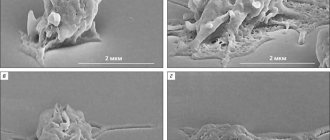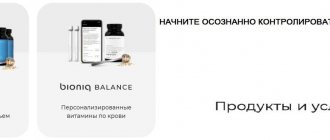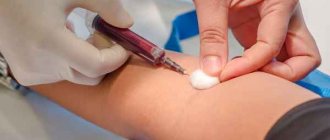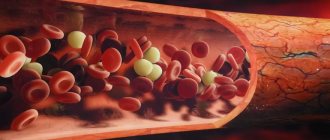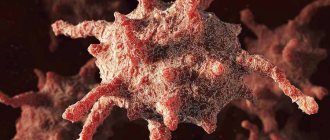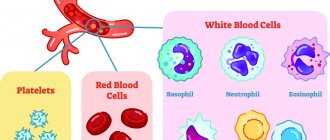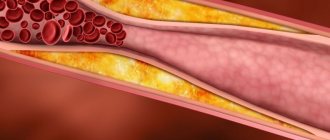Author: Sozinova A.V., obstetrician-gynecologist, has been in continuous practice since 2001. January, 2021.
Synonyms: platelets, platelet count, PC, plt.
Platelets are blood cells, and their concentration is determined during a general blood test. On the CBC form, platelets are designated as platelet count or PC. Blood for studying its composition, including counting the number of platelets, is taken from a finger (capillary) or from a vein. The unit of measurement for platelets is the number (N) of cells multiplied by 109 per liter.
Platelets, like other formed elements, are formed in the red bone marrow. Their lifespan in the bloodstream is about 7–12 days. Destruction and breakdown of cells occurs in the spleen and liver tissues.
The main function of platelets is to carry out hemostasis, that is, to stop bleeding. Contact with damaged tissues causes transformation of cells, up to 10 processes are formed in them, and when they spread, the wound is closed with a platelet mass (thrombus). Thus, platelets prevent large amounts of blood from leaking out of damaged soft tissues.
Another equally important function of platelets is to protect the injured area from the penetration of pathogenic microorganisms (they secrete lysozyme and B-lysine).
Platelets also participate in the processes of hemostasis (maintaining the internal environment of the body), nutrition of the capillary endothelium (the inner layer of the walls of blood vessels) and regenerative processes of damaged tissues due to the release of growth factors that stimulate cell division.
A 2021 scientific paper provides evidence showing that in addition to the above functions, platelets also play an important role in the human immune system.
General information
Platelets are granulocytic blood cells without a biconvex nucleus, formed from plasma cells of the bone marrow. They are presented in different forms - young, adult and mature. The diameter is directly proportional to age: 2-4 microns. Platelets contain granules that create blood clotting proteins, lytic enzymes, phosphatase and cathepsin, create serotonin, calcium ions and ATP, and contain lysosomal enzymes.
One of the most important functions of blood platelets is participation in blood clotting (primary hemostasis).
Platelets bind clotting factors, making blood clots thicker. As a rule, in an inactive state, when the vessel wall is damaged, platelets are directed to the damaged area. Thanks to the pseudopods located on the surface of the body, they are attached to each other and the vascular wall, forming a blood clot, which is an excellent barrier to bleeding. In the active state, platelets are able to change the shape of the body, due to which they increase their area, and this allows them to completely close the damage.
In addition, platelets are able to protect the body from foreign bodies by catching them with the help of pseudopods, and then digesting them with the help of the enzyme lysocine, which is formed from platelet factors (thrombin, thromboxane), from platelet granules. Thus, platelets are important for the immune response, being “killer” cells for foreign agents entering the body.
Blood plates serve as a storage site for serotonin, providing antitumor and radioprotective effects.
Thus, a violation of the number of platelets leads to inhibition of their functions, this certainly leads to disruption of the body’s activity and entails negative symptoms.
Classification of thrombocytosis
Thrombocytosis is classified into 3 types:
- clonal;
- primary;
- secondary.
The first two types are characterized by a similar pathogenesis - the disease develops due to a disorder in stem cells. In the clonal form, cells are affected by tumor processes, platelets begin to form uncontrollably and their interaction with other cells of the system is disrupted. There is a tendency to form blood clots.
Primary thrombosis occurs due to a disruption in the functioning of brain stem cells, in which the proliferation of hematopoietic areas is recorded. This risk group includes older people. The secondary type develops against the background of chronic pathologies that bother the patient.
Normal platelet count in blood
The number of platelets in the body should normally vary from 180 to 320*10^9 for women and from 200 to 400*10^9 for men per liter of blood. Moreover, the number of platelets in women can change during menstruation to 75 * 10^9 per liter of blood, can decrease in the third trimester in pregnant women and, regardless of gender, increase in response to an inflammatory reaction, which seems to be a physiological norm and is not a deviation, without carrying negative symptoms.
In children, the normal platelet count depends directly on the age of the child. For a newborn, the norm will be 100-420*10^9 per liter of blood, and at two weeks of age and up to a year it is 150-350*10^9 per liter of blood. Up to five years, the amount changes slightly to 180-350*10^9 per liter of blood. By the age of seven, the norm reaches 180-450*10^9 per liter of blood.
For prevention, you need to take a blood test at least once a year in order to identify a possible pathology as early as possible and begin its treatment as soon as possible at an early stage, before the development of a severe clinical condition. If a deviation is detected, a blood test is performed more often.
They live in the body for only 9-10 days, after which they are renewed, destroyed in the liver or spleen and re-proliferate in the bone marrow.
Online consultation with infectious disease specialist, allergist-immunologist Natalia Nikolaevna Gordienko
Cost of online consultation: 3500 rubles
Online consultation
During the consultation, you will be able to voice your problem, the doctor will clarify the situation, interpret the tests, answer your questions and give the necessary recommendations.
Causes of low platelet count in blood test
A decrease in the number of platelets in a general blood test below normal to 150*10^9 per liter of blood and below is a pathological condition and is called “thrombocytopenia”. Since this is a condition, not a disease, it only characterizes, being a symptom of a specific disease.
There can be many reasons for a decrease in platelets, and they are all different from each other, so it can sometimes be very difficult to name one at once.
The main causes of thrombocytopenia are:
- Increased platelet destruction.
- Increased platelet consumption.
- Insufficient platelet production.
These three conditions can be the result of an inherited condition in which enzyme activity is impaired, but more often it is an acquired condition due to:
- Suppression of bone marrow activity.
- Hemoblastosis (tumor disease of hematopoietic or lymphoid tissue).
- Disseminated vascular coagulation syndrome (due to various bacterial infections or brain injury).
- Vitamin B12 deficiency.
- Folic acid deficiency.
- Hypersplenism syndrome (an increase in the size of the spleen, as well as an increase in the destruction of blood cells).
- Hemorrhagic diathesis (increased bleeding).
- Immune thrombocytopenia.
- Thrombocytopenic purpura.
- Leukemia (malignant disease of the bone marrow, otherwise called blood cancer).
- Paroxysmal nocturnal or cold hemoglobinuria.
- Collagenosis (connective tissue damage).
Additional reasons for a decrease in platelets in the blood may also be:
- Violation of medication regimen (vancomycin, heparin, sulfamethoxazole, drugs for the treatment of diabetes mellitus).
- Use of chemotherapy drugs.
- Massive blood transfusion.
- Cirrhosis of the liver.
- Myelofibrosis.
- Hepatitis C virus.
- Human immunodeficiency virus (HIV).
- Epstein-Barr virus (infectious mononucleosis).
- Hyperthyroidism.
- Hypothyroidism.
- Hemolytic-uremic syndrome.
- Alcoholism.
Traditional recipes for thrombocytosis
Along with medications, traditional methods are also used to treat this disease.
An effective element in the fight against thrombocytosis is ginger, the method of preparation of which is as follows:
- Grind natural ginger into powder.
- Mix with cane sugar in equal parts.
- 2 tbsp. l. pour 250 ml of boiling water over the mixture.
- Take small sips before lunch.
In addition, traditional healers advise using the following ingredients to prepare medicinal medicines:
- a decoction of Ginko Biloba leaves, taken 2 times a day;
- cocoa without milk and sugar should be drunk before meals in the morning;
- garlic tincture (pour 2 crushed heads with 200 g of vodka and leave to infuse for 1 month). Drink it 1/2 tsp. 2 times a day;
- use of leeches;
- Make a paste from garlic, onion, honey and lemon and use 1 tsp. 3 times a day.
Reducing platelets using folk remedies is necessary in combination with diet and traditional medicine.
Consequences of low platelet count
In a state of low platelet count, disorders subsequently develop, which include frequent bleeding (menstrual and nosebleeds), while the bleeding time increases significantly and becomes difficult to stop. Sudden gum bleeding may develop (not everyone does). Blood clots may be found in urine or stool. Petechiae (red dots resulting from damage to the capillary wall) appear on the skin of the lower extremities, most often the legs. Even minimal damage leads to the formation of ecchymoses (bruises), when normally a bruise would not appear.
The severity of symptoms directly depends on the platelet count. The fewer platelets, the more severe the clinic. If the platelet count is very low, internal bleeding into the digestive tract or even bleeding into the brain may occur.
Even in the presence of a mild clinic, it is recommended to consult a general practitioner in order to prevent this condition.
Platelet diagnostics
At the first appearance of relevant clinical symptoms (bleeding and bruising), it is necessary to consult a specialist, in this case it is a general practitioner. There is no need to postpone going to the doctor until the clinic gets worse, because in this case the treatment will be more difficult and the outcome will be less favorable.
To diagnose thrombocytopenia, you must first take a blood test. If the analysis reveals a low platelet count, the general practitioner may refer you to a hematologist, who will prescribe additional tests, such as:
- Coagulogram with determination of clotting time.
- Blood biochemistry for LDH, ASAT, ALAT and bilirubin.
- Antibody test.
- MRI.
- Ultrasound of the abdominal organs.
- Genetic studies (to exclude hereditary thrombocytopenia).
After conducting research and identifying the true cause of thrombocytopenia, a general practitioner or hematologist prescribes appropriate treatment, which includes eliminating the cause of the decrease in platelet count.
Online consultation with infectious disease specialist, allergist-immunologist Natalia Nikolaevna Gordienko
consultation cost: 1000 rubles
Online consultation
During the consultation, you will be able to voice your problem, the doctor will clarify the situation, interpret the tests, answer your questions and give the necessary recommendations.
Symptoms and manifestations of thrombocytosis
In the primary stage there are no symptoms, but the secondary form has pronounced manifestations, because occurs against the background of the development of chronic inflammatory processes.
The following manifestations are typical:
- fatigue;
- acute stage of a chronic disease;
- general health deteriorates;
- problems with blood vessels;
- bleeding;
- swelling;
- bruises and hematomas not associated with contusions;
- heaviness in the hypochondrium on the right;
- shortness of breath and tachycardia;
- migraine and hypertension.
Most patients learn about the manifestation of the disease from the results of a clinical blood test. It is important that the primary form of the disease can develop into a chronic stage. A patient with secondary type thrombocytosis complains of symptoms that are associated with the underlying disease. It is quickly diagnosed, treated in a timely manner, and blood clotting does not occur.
Prevention
There is no specific prophylaxis for thrombocytopenia. It is recommended to lead a healthy lifestyle, including proper nutrition, normal sleep, not to overload yourself with work, abstain from drinking alcohol and tobacco products, treat infectious diseases in a timely manner and carry out routine vaccinations. Consult a doctor promptly if there is a sudden disturbance in the body’s functioning.
Author: infectious disease doctor. Allergist-immunologist Natalia Nikolaevna Gordienko
Preparing for the study
Before taking the OAC, you should stop drinking alcoholic beverages, fatty, spicy, excessively salty and fried foods the day before the procedure. Blood is donated on an empty stomach, the patient is advised to maintain physical and emotional peace (refrain from sudden movements, climbing stairs, avoid stressful situations) for half an hour before the test. Also, platelet testing is not recommended immediately after recovery from a long-term illness, which may distort the results due to weakened immunity.
Detailed instructions for preparing for a general blood test are here.
